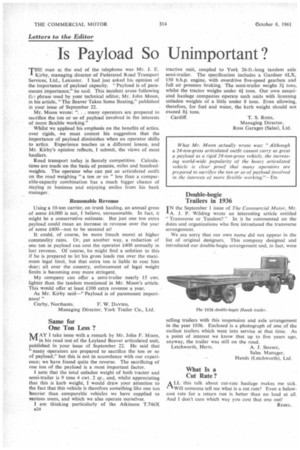Letters to the Editor
Page 58

If you've noticed an error in this article please click here to report it so we can fix it.
Is Payload So Unimportant?
THE man at the end of the telephone was Mr. J. E.
Kirby, managing director of Federated Road Transport Services, Ltd., Leicester. I had just asked his opinion of the importance of payload capacity. "Payload is of paramount importance," he said. This incident arose following CI phrase used by your technical editor, Mr. John Moon, in his article, "The Beaver Takes Some Beating," published in your issue of September 22.
Mr. Moon wrote: ". . . many operators are prepared to sacrifice the ton or so of payload involved in the interests of more flexible working."
Whilst we applaud his emphasis on the benefits of attics. over rigids, we must contest his suggestion that the importance of payload diminishes when an operator shifts to artics. Experience teaches us a different lesson, and Mr. Kirby's opinion reflects, I submit, the views of most hauliers.
Road transport today is fiercely competitive. Calcula. lions are made on the basis of pennies, miles and hundredweights. The operator who can put an articulated outfit on the road weighing "a ton or so " less than a comparable-capacity combination has a much bigger chance of staying in business and enjoying smiles from his bank manager.
Reasonable Revenue Using a 10-ton carrier, on trunk hauling, an annual gross of some £4,000 is not, I believe, unreasonable. In fact, it might be a conservative estimate. But just one ton extra payload could mean an increase in revenue over the year of some £400—not to be sneezed at!
It could, of course, be more (much more) at higher commodity rates. Or, put another way, a reduction of one ton in payload can cost the operator £400 annually in lost revenue. Of "course, he might find a solution to this if he is prepared to let his gross loads run over the maximum legal limit, but that extra ton is liable to cost him dear; all over the country, enforcement of legal weight limits is becoming ever more stringent.
My company can offer a semi-trailer nearly 15 cwt. lighter than the tandem mentioned in Mr. Moon's article. This would offer at least £300 extra revenue a year.
• As Mr. Kirby said—" Payload is of paramount importance!"
Corby, Northants. F. W. DAVIES, Managing Director, York Trailer Co., Ltd.
Same for One Ton Less ?
m AY I take issue with a remark by Mr. John F. Moon, in his road test of the Leyland Beaver articulated unit, published in your issue of September 22. He said that "many operators are prepared to sacrifice the ton or so of payload," but this is not in accordance with our experience; we have found quite the reverse. The sacrificing of one ton of the payload is a most important factor.
I note that the total unladen weight of both tractor and semi-trailer is 9 tons 4 cwt. 2 qr., and, whilst appreciating that this is kerb weight, I would draw your attention to the fact that this vehicle is therefore something like one ton heavier than comparable vehicles we have supplied to various users, and which we also operate ourselves.
I am thinking particularly of the Atkinson T.746X B24 tractive unit, coupled to York 26-ft-long tandem axle semi-trailer. The specification includes a Gardner 6LX, 150 h.h.p. engine, with overdrive five-speed gearbox and full air pressure braking. The semi-trailer weighs 3i tons, whilst the tractor weighs under 41 tons. Our own associated haulage companies operate such units with licensing unladen weights of a little under 8 tons. Even allowing, therefore, for fuel and water, the kerb weight should not exceed 81 tons.
Cardiff. T. S. Ross, Managing Director, Ross Garages (Sales), Ltd.
Double-bogie Trailers in 1936
IN the September 1 issue of The Commercial Motor, Mr. A. J. P. Wilding wrote an interesting article entitled "Transverse or Tandem?" In it he commented on the dates and organizations who first introduced the transverse arrangement.
We are sorry that our own name did not appear in the list of original designers. This company designed and introduced our double-bogie arrangement and, in fact, were selling trailers with this suspension and axle arrangement in the year 1936. Enclosed is a photograph of one of the earliest trailers which went into service at that time. As a point of interest we know that up to five years ago, anyway, the trailer was still on the road.
Letchworth, Herts. A. J. SHAWE, Sales Manager.
Hands (Letchworth), Ltd.
What Is a Cut Rate ?
A LL this talk about cut-rate haulage makes me sick. "Will someone tell me what is a cut rate? Even a belowcost rate for a return run is better than no load at all. And I don't care which way you cost that one out!
REBEL.




























































































































































